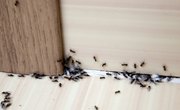
Wasps and bees are all capable of stinging people, but there are some very noticeable differences between the two. Wasps can sting more than once, while bees will die after they sting because their stinger, which is attached to the poison sac, is barbed and remains in the skin, causing the bee to eventually perish when the stinger rips away from the bee's body. Knowing what's the difference between wasps and bees may help prevent unfortunate encounters with either type of insect.
Difference Between Wasp and Bee Body Structures
One way to tell the difference between bees and hornets, yellowjackets and other wasps is appearance. Wasps, hornets and yellowjackets have a slender body that narrows at the waist area. They look like they are shiny and have a smooth body surface. Bees on the other hand are "plumper" than wasps. Bees are also hairier and their back legs are flatter. Bees have a pollen basket on their hind legs while wasps do not. The wasp has back legs that hang down during flight while you can't see a bee's back legs at this time. The stinger on a wasp is not barbed like the stinger on a bee.
Examples of Wasp and Bee Species
Although there are many species of both wasps and bees the most common bees are honeybees and bumblebees while common wasps include paper wasps, yellowjackets and hornets. There isn't really a difference between wasp and hornet species because hornets are a species of wasp that resemble a yellowjacket.
Food Preferences of Wasp vs Bee Species
Bees feed on nectar and pollen from flowers, occasionally getting food from trash in the form of sweet leftovers. Wasps are carnivorous predators that capture other insects to feed to their young in the nest. Adult wasps, however, feed on nectar, honey dew and rotting fruit.
Benefits of Wasps and Bees
Both wasps and bees are very beneficial to nature. Honeybees have been estimated to be responsible for up to 80% of the pollination of fruit trees, vegetable plants and legumes as well as ornamental flowers. Bumblebees also play an important role in pollinating many plant species. Wasps control many insect populations with their carnivorous ways. Flies, crickets, caterpillars and other insect nuisances all fall victim to wasps.
Wasp v Bee Homes
There are major differences between wasps and bees in where they make their homes. Both are found on every continent except for Antarctica.
Wasps will construct their nests from a pulp-like secretion that they make by chewing wood fibers and mixing it with saliva. Yellowjackets and hornets will build a series of combs one on top of another and surround them with an envelope of pulpy layers. Yellowjackets will build theirs below the ground in holes they "borrow" from animals or in hollowed trees, shrubs, inside the walls of structures, and underneath the eaves of buildings. Hornets can make their homes up in trees or along the side of a building. Paper wasps will build a single paper comb with no surrounding envelope under just about any horizontal surface area.
Honey bees, however, make a string of vertical combs out of wax. They can nest in tree cavities but most of their nests today come from humans in the form of prefabricated hives. Bumblebees call empty burrows and openings in buildings their home.
Cold Weather Impact on Wasps and Bees
In the cooler fall months wasps will change their focus from insects and other protein sources to carbohydrates. If you have ever gone to your kid's soccer games in the autumn you have undoubtedly noticed yellowjackets flying about, landing on soda cans and in garbage receptacles. They are looking for anything sweet that they can eat. Wasps and bumble bee colonies do not survive the winter in cold climates; only new queen bees survive through the cold, hidden wherever they can stay warm. Honeybee colonies, however, can live for more than one year.
References
About the Author
John Lindell has written articles for "The Greyhound Review" and various other online publications. A Connecticut native, his work specializes in sports, fishing and nature. Lindell worked in greyhound racing for 25 years.
Photo Credits
www.ent.orst.edu
